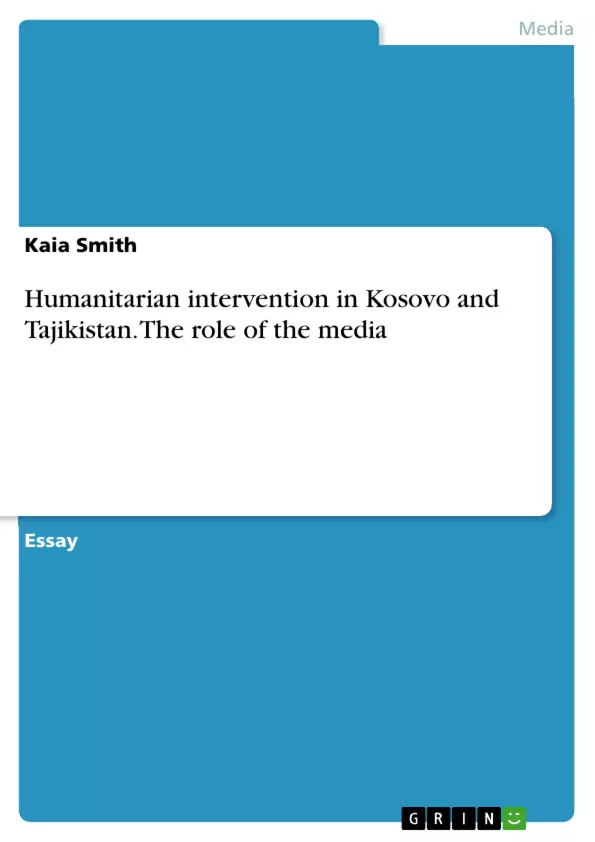In looking at the reasons behind detrimental effects of humanitarian aid, I attempt to explore the following question: how does the media affect the success of humanitarian aid intervention efforts in large scale political violence?
I hypothesize that high levels of media coverage of such situations will lead to decreased effectiveness of humanitarian intervention. Much important information is lost and extraneous information is added throughout the life and travels of a news story. This, in turn, leads to faulty public opinion and thus unsound demands and views on humanitarian action. Depending on the influence of actors’ self-interest(s), this negative relationship may be magnified; however my hypothetical relationship does not depend on such political interests.
The cases I have chosen to test this hypothesis are Kosovo and Tajikistan. I chose these cases for multiple reasons. First, they are both internal, violent conflicts. Since both of these conflicts occurred in areas close to developed countries in Western Europe, these cases should be relatively equal in terms of opportunities for foreign interest in intervention. Both instances of violence in Kosovo and Tajikistan involve political conflict in which foreign humanitarian intervention was implemented. All cases illustrated high levels of civil violence between different political and ethnic groups (with at least 15,000 deaths). Interventions all took place during the 1990s, so media communications can be evaluated from a similar technological standpoint: the first interventions in Kosovo took place in 1999, and Tajikistan in 1992.
Inhaltsverzeichnis (Table of Contents)
- Kosovo
- Negative Consequences of Intervention
- Role of the Media
- Analysis
- Tajikistan
- UN Intervention
- Role of the Media
- Analysis
- Kosovo and Tajikistan: Comparison of Media Influence
Zielsetzung und Themenschwerpunkte (Objectives and Key Themes)
This text examines the influence of media coverage on the effectiveness of humanitarian intervention in instances of large-scale political violence. It investigates whether high levels of media coverage lead to a decrease in the effectiveness of intervention. The text hypothesizes that extensive media coverage can distort public opinion, leading to unsound demands and views on humanitarian action. The study focuses on the cases of Kosovo and Tajikistan, analyzing how media coverage shaped public perception and impacted the effectiveness of interventions in these conflicts.
- The relationship between media coverage and the effectiveness of humanitarian intervention.
- The role of media in shaping public opinion and influencing policy decisions regarding humanitarian intervention.
- The impact of foreign media coverage on the dynamics of internal conflicts and the influence of international actors.
- A comparative analysis of the media's role in two different cases of humanitarian intervention: Kosovo and Tajikistan.
Zusammenfassung der Kapitel (Chapter Summaries)
1. Kosovo
This chapter explores the historical context of the Kosovo conflict, tracing the rise of tensions between Albanian and Serbian populations. It highlights the role of the Kosovo Liberation Army (KLA) and the Serbian government's response, culminating in the international community's involvement in the conflict. The chapter discusses the dynamics of the KLA's strategy and the international community's response, emphasizing the role of media coverage in shaping perceptions and influencing intervention efforts.
1.1 Negative Consequences of Intervention
This section delves into the negative consequences of foreign humanitarian intervention in Kosovo. It examines the impact of NATO bombings, including civilian casualties and the destruction of infrastructure, highlighting the unintended consequences of military intervention.
Schlüsselwörter (Keywords)
The key terms and concepts explored in this text include humanitarian intervention, media coverage, public opinion, political violence, Kosovo, Tajikistan, foreign intervention, media influence, NATO, UN, and the Kosovo Liberation Army (KLA). The study analyzes the relationship between these concepts, examining how media coverage influences the effectiveness of humanitarian intervention in real-world contexts.
- Quote paper
- Kaia Smith (Author), 2011, Humanitarian intervention in Kosovo and Tajikistan. The role of the media, Munich, GRIN Verlag, https://www.grin.com/document/411999



